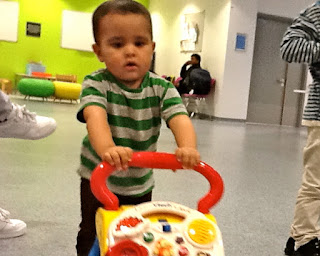Asa's
last dose of chemo was given 6 weeks ago, and he's now largely recovered from
the side effects -- he's comfortable, his appetite has returned, and little
hairs are sprouting all over his scalp.
I’ve
been remiss in sharing this news, in part because as soon as the chemo
finished, Asa developed chicken-pox, and we were thrown back into emergency mode.
He
broke out in spots on May 28, and at that point, his immune system was still
compromised, and we were afraid the chicken-pox was going to be unusually
severe.
On
doctors' advice, Asa was kept in hospital for 10 days on IV Aciclovir, a drug
that slows the reproduction of the virus.
In
the event, the chicken-pox was mild, and the spots didn't seem to cause him
much pain.
There
was still some systemic imbalance that needed to be sorted out afterwards: Until last week, his potassium levels were still low, and we continued
giving him supplements through his NG tube.
But by
last Saturday, he had normalized, and we pulled out the NG tube.
 |
| Asa, a few days before his NG tube was removed. |
Perhaps
that would have been the appropriate time to have thrown a party.
It's
difficult to describe what a relief it is not to be giving Asa medicine, after
5 months when he rarely went without at least one or two doses of some drug or
another each day.
What
next?
Many
people would like to know whether the chemo worked.
We
may have partial answers within the next couple of days.
This
afternoon we travel to London, where Asa will have two eye exams -- one a
vision test at which he's presented with various stimuli and the doctor tries
to evaluate how well he sees; and another, tomorrow, when his eyes are examined
while he's under anaesthetic.
We
have to think about these tests not as the final exams after chemo, but as the
first after chemo.
The
reason is that, even if the tumours appear quiescent, there's still a chance
they could reactivate in future.
Asa
will need exams under anaesthetic roughly on a monthly basis from now until
he's about 5 years old (when the risk of new tumour activity decreases).
The
prognosis we'll get tomorrow, then, probably won't be for the long term, but
"for now".
Thank
you!
This
is a good time to acknowledge our gratitude for the people and institutions
that have helped us get through the last 5 months. A short and certainly not exhaustive list must include:
1.
Selam – who first
noticed the signs of retinoblastoma, and sounded the alarm, and who has done
more than anyone to bring Asa this far
2.
The National Health Service – which has
given us access to excellent medical care, from specialists to community nurses
who visit our home every week
3.
The grandparents,
especially Kay and Clive, who have provided support to us all throughout
4.
Other friends and
family who have kept our spirits up through the difficult times.
Thank
you all!
A
few words from Asa
It’s
partly a testament to the contributions of all these people, and partly due to
his own resilience, that Asa's been developing normally though all of this.
Right
now he has a receptive vocabulary larger than we probably realise. He knows the
words -- in Amharic or English or babytalk -- for breast ("tuut"),
blender ("Nnnnngggg!"), hand-washing ("water-play"),
piggy-back ("che-che"), "up", and "down".
The
comprehensible utterances he produces are limited to daddy ("Adada"),
mummy ("Mama", which for some reason he says much less commonly), and
"There!"
Beyond
this, he is a great mimic, imitating sounds -- the noises of the washing
machine, cars, coughs and sneezes, and the melodies of familiar songs
("This old man…" and "Twinkle, twinkle, little star") --
and actions like eating, scrubbing, and sweeping: things he’s seen us do a lot.
For
a long time Asa was a slacker in terms of chewing his food, but he's making
progress on that front now, and in the last few days he's chewed and swallowed bread
and raisins. Biltong next.














